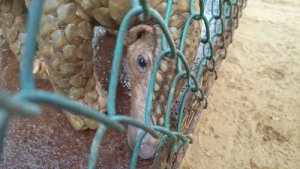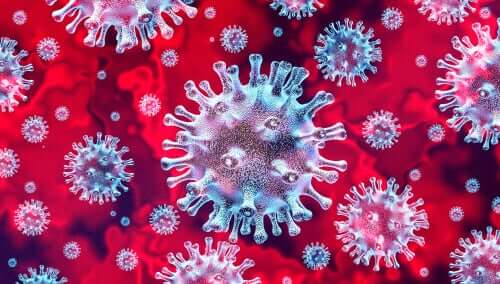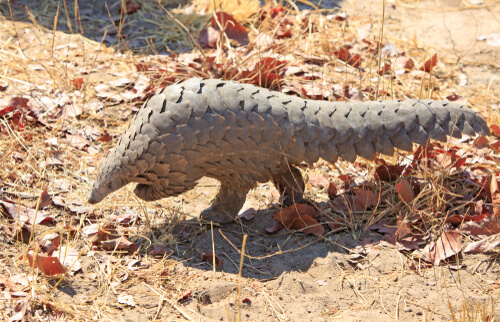Is the Pangolin Responsible for Transmitting Coronavirus COVID-19?

As we write this article, the scientific community is investigating whether or not the pangolin, or other animals, are responsible for transmitting coronavirus COVID-19 or not. It’s important to point out that coronaviruses have been well known in veterinary circles for decades.
In general, coronaviruses infect birds and mammals in a species-specific manner. In this sense, we already know of specific strains of coronavirus that infect humans, dogs, cats, rodents, rabbits, ferrets, cows, turkeys, and pigs.
Below, we’ll conduct a brief summary of what we know about COVID-19 to date.
Coronaviruses and infection in humans
Scientists first identified the coronaviruses for at the end of the 1970s. Since that time, they’ve been aware of the existence of four CoV that infected humans (HCoV). These strains cause mild infections, such as the common cold.
Interestingly, these four low-pathogenicity HCoV also have links to the coronaviruses that affect animals. A variety of studies have analyzed genome sequences available today. These studies suggest that the animal species below are the natural hosts, or reservoirs, of these strains.
- HCoV-HKU1: Rodents are a natural reservoir.
- HCoV-NL63: Bats are a natural reservoir.
- HCoV-OC43: Rodents are a natural reservoir: Cattle are intermediary reservoirs.
- HCoV-229E: Bats are natural reservoirs: Alpacas intermediary reservoirs.

Highly pathogenic coronaviruses for humans
Until the years 2002 and 2003, the CoV were not considered highly pathogenic for humans. It was at this time that an outbreak of the acute respiratory syndrome coronavirus (SARS-CoV) occurred in the province of Guangdong, China. This virus spread worldwide.
Later, in the year 2012, another high pathogenic coronavirus, Middle East respiratory syndrome (MERS-CoV) appeared in Saudi Arabia and other countries in the Middle East. In both cases, the general belief was that the virus originated in bats. What’s more, evidence suggested that these species are intermediary reservoirs of the virus:
- SARS-CoV: Bats, masked palm civets (Paguma larvata)
- MERS-CoV: Bats, dromedary camels
- COVID-19: Bats, intermediary reservoir unknown
Given these two precedents, scientists have formulated the hypothesis that COVID-19 may also be of animal origin. In fact, genome sequence analysis warrants that COVID-19 also originated in bats. However, the intermediate reservoir remains unknown.

What does it mean that the pangolin could be the possible intermediary reservoir?
Normally, viruses spread among animals of the same species. On occasion, viruses can cross over and recombine and cause illness in another species.
It’s important to know that these viruses can spread from animals to human beings in two main ways:
- Directly from the natural host or from its secretions that are contaminated by the virus.
- Through another organism that helps as an intermediate host, or reservoir.
It’s worth pointing out that the genes of viruses are separated in segments. So, a segmented genome allows the viruses of different species to mix together or recombine in order to create new viruses. Most often in these cases, the viruses of two different species infect the same person or animal at the same time. This event is known as co-infection.
As a result, the new virus possesses new properties. For example, it may be able to infect human beings and spread easily from one person to another, causing a pandemic. Given the newness of the viral structure, most people will possess little to no protection against the infection.
So, is the pangolin responsible for transmitting coronavirus?
Epidemiological studies revealed that many of the first patients were exposed to wildlife in the Wuhan seafood wholesale market. This venue is the largest seafood market in the center of China. There, they exhibit different species of bats, bison, snakes, Chinese bamboo rats, etc.
It’s often common for them to sell different breeds of cats, porcupines, dogs, birds, and other farm animals. These markets are known as “wet markets“. This is because traditionally they are places where they sell dead and living animals out in the open.
It’s easy to imagine that the blood and other bodily fluids originating from different animal species represent an exceptional source of contagion.
It’s important to highlight the fact that the pangolin was not on the list of animals at the market. This is perhaps because the commercialization of this animal is illegal. And, since January 1st, 2020, Wuhan South China Seafood Wholesale Market, as it is also called, has been closed by order of the municipal government of Wuhan.
You may also want to read: Bird Flu: The Impact on Poultry Farming
Evidence that supports the pangolin being responsible for transmitting coronavirus
A group of North American scientists made an important discovery regarding COVID-19. They identified a high similarity of genome sequences between COVID-19 and a genome of coronavirus reconstituted from a pangolin database.
Another group from the University of Hong Kong isolated viruses using the tissue of pangolins. Their analysis of the sequences of viral genomes determined the presence of two new coronaviruses. These genomes have a similarity of approximately 85.5 to 92.4 percent with COVID-19.
Very recently, investigators in Guangzhou, China, have suggested that pangolins (Manis pentadactyla) are the likely intermediary hosts of COVID-19 for humans. This suggestion originated from the detection of CoV in pangolins that appear to be closely related to COVID-19.
This information comes from the declarations of the dean of the China Agricultural University in Beijing. However, his declarations have not been reported in any scientific article. Just the same, it’s important to handle the information with caution, since genetic analysis is still underway.
If the pangolin is responsible for transmitting the coronavirus, how does it do it?
The pangolin is the most trafficked animal on the plant. This small mammal is elusive, has nocturnal habits, and has scaly skin. Unfortunately, popular beliefs are that the diverse parts of its body possess healing properties in traditional medicine. This refers especially to their scales, but also their fetuses, bones, and claws. If the pangolin is responsible for transmitting coronavirus, then it will be because of the way that humans use this animal.
Final note
The appearance of COVID-19 is an excellent example of the close relationship that exists between the health of animals and humans, the state of the ecosystem, and human habits.
Today, we recognize the fact that many viruses have existed in natural reservoirs for a long time. We also recognize that human activity is in great part to blame for the constant spread of viruses from natural hosts to humans and other animals. This includes modern agricultural practices and urbanization.
Therefore, the most effective way to prevent viral zoonosis is my maintaining the barriers between natural reservoirs and human society.
If the pangolin is truly responsible for transmitting coronavirus, then the handling of these animals requires considerable precaution. Therefore, their commercialization should be strictly prohibited in China and in the rest of the world.
*Latest update on March 26th 2020. Scientists have confirmed that the pangolin is responsible for carrying viruses similar to COVID-19
All cited sources were thoroughly reviewed by our team to ensure their quality, reliability, currency, and validity. The bibliography of this article was considered reliable and of academic or scientific accuracy.
- Wong, M. C., Cregeen, S. J. J., Ajami, N. J., & Petrosino, J. F. (2020). Evidence of recombination in coronaviruses implicating pangolin origins of nCoV-2019. bioRxiv.
- Li, J., Li, J., Xie, X., Cai, X., Huang, J., Tian, X., & Zhu, H. (2020). Game consumption and the 2019 novel coronavirus. The Lancet Infectious Diseases.
- Heinrich, S., Wittmann, T. A., Prowse, T. A., Ross, J. V., Delean, S., Shepherd, C. R., & Cassey, P. (2016). Where did all the pangolins go? International CITES trade in pangolin species. Global Ecology and Conservation, 8, 241-253.
- Lam, T. T. Y., Shum, M. H. H., Zhu, H. C., Tong, Y. G., Ni, X. B., Liao, Y. S., … & Leung, G. M. (2020). Identification of 2019-nCoV related coronaviruses in Malayan pangolins in southern China. bioRxiv.
- Li, J., Li, J., Xie, X., Cai, X., Huang, J., Tian, X., & Zhu, H. (2020). Game consumption and the 2019 novel coronavirus. The Lancet Infectious Diseases.
This text is provided for informational purposes only and does not replace consultation with a professional. If in doubt, consult your specialist.